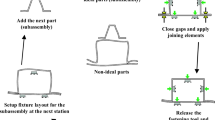Abstract
Assembly success requires an integrated view of assembly sequence, joint configuration, and tolerance fields setting. As a result of incompleteness and uncertainty of design information, it needs to introduce qualitative analysis and reasoning into quantitative methods to help and instruct designers in the project conceptual design stage. A proposed framework for vehicle conceptual assembly design system is presented in the paper. The heuristic algorithm is improved to increase efficiency such as uncertainty presentation in qualitative analysis, fuzzy inferring, and qualitative reasoning of uncertainty knowledge. Some continuous improvement in knowledge-based system is used to help assembly solution generation and greatly increase analysis efficiency. Practical application is broadened to perfect the quantitative and qualitative simulation program. The research will help to construct the big and uniform platform of vehicle body digital concurrent design.
Similar content being viewed by others
References
Gottipolu RB, Ghosh K (1997) Representation and selection of assembly sequences in computer-aided assembly process planning. Int J Prod Res 35(12):3447–3465
Lazzerini B, Marcelloni F (2000) A genetic algorithm for generating optimal assembly plans. Artif Intell Eng 14:319–329
Marian RM, Luong LHS, Abhary K (2003) Assembly sequence planning and optimization using genetic algorithms Part I. Automatic generation of feasible assembly sequences. Applied Soft Computing Journal 2(3):223–253
Wang Y, Liu JH, Li LS (2009) Assembly sequences merging based on assembly unit partitioning. Int J Adv Manuf Technol 45(7):808–820
Zhao S, Li Z (2009) Formalized reasoning method for assembly sequences based on Polychromatic Sets theory. Int J Adv Manuf Technol 42(9):993–1004
Bi ZM, Zhang WJ (2001) Modularity technology in manufacturing: taxonomy and issues. Int J Adv Manuf Technol 18:381–390
Lipson H, Pollack JB, Suh NP (2001) Promoting modularity in evolutionary design, Proceedings of DETC’01 2001 ASME Design Engineering Technical Conferences September 9–12, Pittsburgh, Pennsylvania, USA
Huang CC (2000) Overview of modular product development. Proc Natl Sci Counc ROC (A) 24(3):149–165
Gershenson JK, Lai X (2008) Representation of similarity and dependency for assembly modularity. Int J Adv Manuf Technol 37(7):803–827
Liu SC, Hu SJ (1998) Sheet metal joint configurations and their variation characteristics. J Manuf Sci Eng 120(5):461–467
Nikolaidis E, Long L, Ling Q (2000) Neural networks and response surface polynomials for design of vehicle joints. Comput Struct 75:593–607
Lee B, Saitou K (2003) Assembly synthesis with subassembly partitioning for optimal in-process dimensional adjustability. ASME Des Eng Tech Conf 2 A:257–268
Zhou J, Chen G, Lai X, Lin Z (2007) A genetic algorithm to process-oriented optimization of joint configuration based on a skeleton model. ASME Des Eng Tech Conf 32(11):1245–1252
Gao J, Chase KW, Magleby SP (1995) Comparison of assembly tolerance analysis by the direct linearization and modified Monte Carlo simulation methods. Proceedings of the ASME Design Engineering Technical Conferences, Boston, pp 353–360
Chase KW, Magleby SP (1997) A comprehensive system for computer-aided tolerance analysis of 2-D and 3-D mechanical assemblies, Proceedings of the 5th International Seminar on Computer-Aided Tolerancing Toronto, Canada, 27–29
Gao J, Chase KW, Magleby SP (1998) General 3-D tolerance analysis of mechanical assemblies with small kinematics adjustments. IIE Transactions 30:367–377
Whitney DE, Gilbert OL (1993) Representation of geometric variations using matrix transforms for statistical tolerance analysis in assemblies. Proc- IEEE Int Conf Robot Autom 2:314–321
Lee S, Yi C (1998) Statistical representation and computation of tolerance and clearance for assemblability evaluation. Robotica 16(3):251–264
Johannesson H, Soederberg R (2000) Structure and matrix models for tolerance analysis from configuration to detail design. Research in Engineering Design—Theory, Applications, and Concurrent Engineering 12(2):112–125
Marziale M, Polini W (2009) A review of two models for tolerance analysis of an assembly: vector loop and matrix. Int J Adv Manuf Technol 43(11):1106–1123
Zhang C, Wang HP (1992) Simultaneous optimization of design and manufacturing. Tolerances with process (machine) selection. CIRP Ann, Manuf Technol 41(1):569–572
Prisco U, Giorleo G (2002) Overview of current CAT systems. Integr Comput-Aided Eng 9(4):373–387
Schlatter B (1996) Computer-aided 3D tolerance analysis of disk drives. IBM J Res Dev 40(5):537–542
Author information
Authors and Affiliations
Corresponding author
Rights and permissions
About this article
Cite this article
Shaoyun, C., Yubing, L., Xinmin, L. et al. Vehicle conceptual assembly variation analysis system. Int J Adv Manuf Technol 51, 1111–1120 (2010). https://doi.org/10.1007/s00170-010-2665-8
Received:
Accepted:
Published:
Issue Date:
DOI: https://doi.org/10.1007/s00170-010-2665-8




